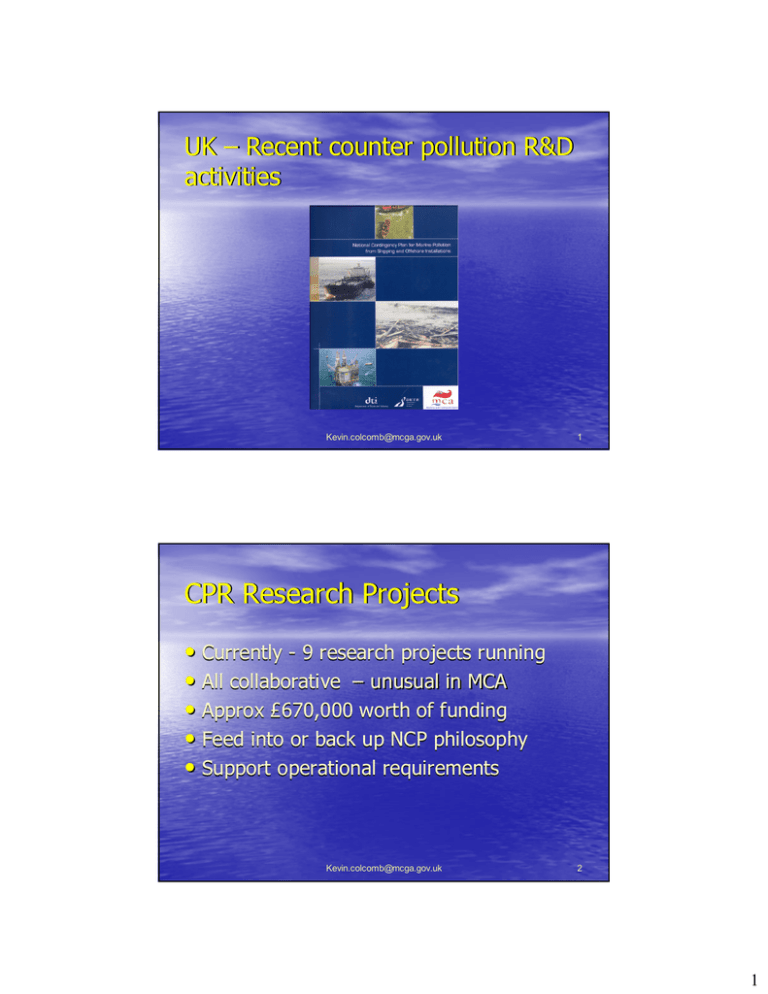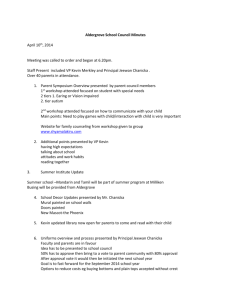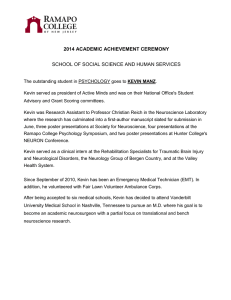CPR Research Projects UK – Recent counter pollution R&D
advertisement

UK – Recent counter pollution R&D activities Kevin.colcomb@mcga.gov.uk 1 CPR Research Projects • Currently - 9 research projects running • All collaborative – unusual in MCA • Approx £670,000 worth of funding • Feed into or back up NCP philosophy • Support operational requirements Kevin.colcomb@mcga.gov.uk 2 1 Objectives • Move “far from market” project areas • Target stakeholder beneficiaries • Fair stakeholder funding • Reduce financial burden on MCA Kevin.colcomb@mcga.gov.uk 3 Historic • Project origins – Common stakeholder interests • Involvement can stimulate interest – Multifarious stakeholder benefits – Project rationale/extent/scope – Often through multi agency working gps • Project funding – More for less? Kevin.colcomb@mcga.gov.uk 4 2 Collaborative Research • Range of stakeholders contributing • Advantages/disadvantages – Project management by committee – Government/Industry mix – Clash of objectives/project direction – Time consuming – Maintaining momentum/direction – All on board / signed up Kevin.colcomb@mcga.gov.uk 5 Limiting viscosity project • Controversial issue • Innovative approach • 4 stakeholders • Responder, regulator, industry, MMS • Contributions in kind • Limited funding available Kevin.colcomb@mcga.gov.uk 6 3 Sea trials - 2003 Kevin.colcomb@mcga.gov.uk 7 Outcomes • sea temperature of 15ºC • oil viscosities of 2,000 cP (IFO-180) • 7,000 cP (IFO-380) • waves associated with wind speeds of between 7 and 14 knots Kevin.colcomb@mcga.gov.uk 8 4 IFO 180 • IFO- 180 fuel oil totally and rapidly dispersed by • • Corexit 9500 at a nominal DOR of 1:25 at 12 knots wind speed. Superdispersant 25 and Agma Superconcentrate DR 379 somewhat less effective, but still moderate dispersion when use at a nominal DOR of 1:25. At lower wind speeds of 7 to 8 knots, Corexit 9500 at nominal DOR of 1:25 was seen to be less effective, but still caused moderately rapid dispersion of IFO-180. Kevin.colcomb@mcga.gov.uk 9 IFO 380 • IFO -380 fuel oil was not rapidly and totally • • dispersed by any of the three dispersants at any of the treatments rates, ranging from nominal DORs of 1:25 to 1:100 at wind speeds of 7 to 9 knots. At wind speeds of 13 - 14 knots, the performance of both Superdispersant 25 and Corexit 9500 at a DOR of 1:25 improved to produce moderately rapid dispersion of IFOIFO-380. The performance of Agma Superconcentrate DR 379 was less than that of the other two dispersants, but was not tested at the highest wind speeds. Kevin.colcomb@mcga.gov.uk 10 5 Consequences of not doing • Myths remain intact • Effectiveness argument continues • Potential for hindering cost recovery Kevin.colcomb@mcga.gov.uk 11 Ecological effects of dispersant use • Primary UK response method • Controversial, often disputed • Operator/regulators/industry funding • Will feed into Defra review • Competent contractor • Benefits – All stakeholders involved and agreed Kevin.colcomb@mcga.gov.uk 12 6 Consequences of not doing • MCA open to challenge on dispersant philosophy (happens anyway) • Limited data to demonstrate benefits Kevin.colcomb@mcga.gov.uk 13 Summary conclusions • Although chemically dispersed oil may initially impact mussels and amphipods to a greater extent than would untreated oil, organisms are mostly able to recover to the same extent as control organisms or to those exposed to oil alone. • The exception to this were some exposures of CC-9527 dispersed waterwater-accommodated fractions of ANS oil to mussels and amphipods where dispersion led to the highest concentrations of oil in the water and sediments. • Thus, in scenarios where successive tides further dilute these dispersant- treated oils, a net environmental benefit may be maintained and the goal of dispersant use achieved. Kevin.colcomb@mcga.gov.uk 14 7 Resource mapping project • Update 1990 paper based maps and • • • • produce new digitised maps 10 stakeholders – public/private Challenging project management Essential stakeholder involvement Question of contractor competence Kevin.colcomb@mcga.gov.uk 15 Project Funding Partners Kevin.colcomb@mcga.gov.uk 16 8 Kevin.colcomb@mcga.gov.uk 17 Outcomes • Highlighted the need for government wide standards of data collection, storage, etc • MAGIC website is maintained / regularly updated by Defra • We can add new data – places of refuge? • www.magic.gov.uk Kevin.colcomb@mcga.gov.uk 18 9 Consequences of not doing • MCA name on out of date maps (reputation) • Old maps remain basis for regional cp’s • Decisions made on out of date data Kevin.colcomb@mcga.gov.uk 19 VHFO Risk Assessment Project • To id quantities and routeings of VHFOs being • • • transported within and through the Bonn Agreement pollution control zone. To assess the env and economic risks posed by this transport. To evaluate, plan and implement appropriate counter--pollution measures. counter To produce the risk assessment on a GIS platform. Kevin.colcomb@mcga.gov.uk 20 10 TOTAL_TONNAGE_CARGO_ROUTE by Tonnages 0 t o 1, 000, 000 1,000,000 t o 2, 000, 000 2,000,000 t o 5, 000, 000 5,000,000 t o 10,000, 000 10,000,000 t o 20,000, 000 20,000,000 t o 30,100, 000 Annual tonnages of VHFO cargoes along routes passing through the UKPCZ in 2003 Kevin.colcomb@mcga.gov.uk 21and scenario locations (green stars). ECE monitoring • • • • • • Anglo / French joint ops Qu of phosphate impact on ecosystem Deliberate release or recover – cost?! Defra / MCA – collaboration / funding PML / Soton Uni – 2 discrete projects Outcome – no real impact – OK to release W re c k s ite Kevin.colcomb@mcga.gov.uk 22 11 Project outputs • Project evaluation • Marine Information Note • Project Report – on MCA site • Greater benefits through collaboration with OGD’s and Industry Kevin.colcomb@mcga.gov.uk 23 New projects • Waste management (potential showstopper) – Not mainstream MCA work area – But successfully pulling stakeholders together – Overall benefits to UK plc • Potentially polluting shipwrecks • Surface cleaner efficacy Kevin.colcomb@mcga.gov.uk 24 12 New projects 06/07 • Design of large scale waste treatment plant • Techniques for dealing with submerged and sunken oil • HNS Risk assessment Kevin.colcomb@mcga.gov.uk 25 Waste treatment options • To identify all sites for final recovery and disposal of • • • • hazardous waste in the UK. To identify oil treatment facilities (both fixed and mobile) available in the UK and their capacity for all available treatments: incineration, oily water separation, the outcome being a comprehensive inventory of the UK infrastructure for dealing with oily waste. To investigate and collate the contingency arrangements of all UK maritime local authorities.. Develop a UK guidance document for handling large quantities of oily waste to achieve national consistency of approach on infrastructure design criteria. Identify any new waste management technologies dealing with oil related wastes Kevin.colcomb@mcga.gov.uk 26 13 Potentially polluting wrecks • To identify locations and identity all potentially • • • polluting wrecks in UK waters. Establish methodology to best calculate quantities and types of pollutants are present on each wreck type. Agree best format for database structure – including how best to categorise information. To provide a clear, well structured and searchable, dynamic GIS based database creating a knowledge platform which will readily facilitate risk assessment exercises for all UK waters and coastline. Kevin.colcomb@mcga.gov.uk 27 Evaluation of surface cleaners • To develop robust protocol in electronic format for cleaning hard rock surface and man made structure using a range of cleaning techniques • Development of a decision making tool to aid the identification of appropriate, fit for purpose techniques for a range of oil and emulsion types over a range of hard substrates. To produce a guidance manual for shoreline cleanclean-up operatives describing best practice for cleaning hard coast structures. • To develop a robust guide for developing environmental impact assessments for each cleaning technique, to include primary methodology for mitigating environmental damage. Kevin.colcomb@mcga.gov.uk 28 14 Design of large scale waste treatment plant • To design a treatment plant capable of dealing with • • • • • • thousands of tonnes oily waste. To determine best technology and specific machinery for each element of the operation taking into account a range of waste types. Critically appraise relative costings for each available process Identify sourcing of appropriate equipment To establish relationships between process treatment technology and nature of material to be processed. Water content, sand and gravel, fines, large foreign debris To establish criteria for siting of waste process plant logistics, to the satifaction of all UK environmental regulators. To determine plant Kevin.colcomb@mcga.gov.uk footprint requirements. 29 Techniques for dealing with submerged and sunken oil • To identify parameters and their significance • • essential to develop realistic modelling of partially submerged and sunken VHFO’s in seawater. Develop a methodology to incorporate such algorithms into existing modelling capability. To determine appropriate and realistic oil recovery techniques for submerged and sunken oils. Kevin.colcomb@mcga.gov.uk 30 15 HNS Risk assessment • To identify the highest risk HNS for the UK PCZ • • and determine priorities for modelling and practical work. To determine the fate and effects of higher risk HNS in the marine environment. Produce a guidance document, easily searchable for prediction of fate and effects of generic higher risk HNS. Kevin.colcomb@mcga.gov.uk 31 Thank you for listening That’s the sharp end - not so sharp as it used to be of course . Questions? Kevin.colcomb@mcga.gov.uk Kevin.colcomb@mcga.gov.uk 32 16



